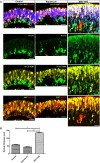Role of mTORC1 activity during early retinal development and lamination in human-induced pluripotent stem cell-derived retinal organoids
- PMID: 35136019
- PMCID: PMC8826382
- DOI: 10.1038/s41420-022-00837-5
Role of mTORC1 activity during early retinal development and lamination in human-induced pluripotent stem cell-derived retinal organoids
Abstract
Retinal organoids derived from human-induced pluripotent stem cells (hiPSC) are powerful tools for studying retinal development as they model spatial and temporal differentiation of retinal cell types. Vertebrate retinal development involves a delicate and coordinated process of retinal progenitor cell (RPC) differentiation, and the mammalian target of rapamycin complex 1 (mTORC1) has been reported to play a significant role in this complex process. Herein, using hiPSC-derived retinal organoids, we identify the time-dependent role of mTORC1 in retinal development, specifically in retinal ganglion cell (RGC) differentiation and the retinal lamination process, during the early stages of retinal organoid (RO) development. mTORC1 activity in ROs was the highest at 40 days of differentiation. MHY1485-induced hyperactivation of mTORC1 during this period resulted in a significant increase in the overall size of ROs compared to the untreated controls and rapamycin-treated Ros; there was also a marked increase in proliferative activity within the inner and outer layers of ROs. Moreover, the MHY1485-treated ROs showed a significant increase in the number of ectopic RGCs in the outer layers (indicating disruption of retinal laminar structure), with robust expression of HuC/D-binding proteins in the inner layers. These results demonstrate that mTORC1 plays a critical role in the development of hiPSC-derived ROs, especially during the early stages of differentiation.
© 2022. The Author(s).
Conflict of interest statement
The authors declare no competing interests.
Figures







Similar articles
-
Three-Dimensional Retinal Organoids Facilitate the Investigation of Retinal Ganglion Cell Development, Organization and Neurite Outgrowth from Human Pluripotent Stem Cells.Sci Rep. 2018 Sep 28;8(1):14520. doi: 10.1038/s41598-018-32871-8. Sci Rep. 2018. PMID: 30266927 Free PMC article.
-
A controllable perfusion microfluidic chip for facilitating the development of retinal ganglion cells in human retinal organoids.Lab Chip. 2023 Aug 22;23(17):3820-3836. doi: 10.1039/d3lc00054k. Lab Chip. 2023. PMID: 37496497
-
Culture Systems of Dissociated Mouse and Human Pluripotent Stem Cell-Derived Retinal Ganglion Cells Purified by Two-Step Immunopanning.Invest Ophthalmol Vis Sci. 2018 Feb 1;59(2):776-787. doi: 10.1167/iovs.17-22406. Invest Ophthalmol Vis Sci. 2018. PMID: 29392326
-
Inducible Pluripotent Stem Cells to Model and Treat Inherited Degenerative Diseases of the Outer Retina: 3D-Organoids Limitations and Bioengineering Solutions.Cells. 2021 Sep 20;10(9):2489. doi: 10.3390/cells10092489. Cells. 2021. PMID: 34572137 Free PMC article. Review.
-
Retinal Organoids: Cultivation, Differentiation, and Transplantation.Front Cell Neurosci. 2021 Jun 28;15:638439. doi: 10.3389/fncel.2021.638439. eCollection 2021. Front Cell Neurosci. 2021. PMID: 34276307 Free PMC article. Review.
Cited by
-
Exosomes from Human iPSC-Derived Retinal Organoids Enhance Corneal Epithelial Wound Healing.Int J Mol Sci. 2024 Aug 16;25(16):8925. doi: 10.3390/ijms25168925. Int J Mol Sci. 2024. PMID: 39201611 Free PMC article.
-
Advanced 3D imaging and organoid bioprinting for biomedical research and therapeutic applications.Adv Drug Deliv Rev. 2024 May;208:115237. doi: 10.1016/j.addr.2024.115237. Epub 2024 Mar 5. Adv Drug Deliv Rev. 2024. PMID: 38447931 Free PMC article. Review.
-
Intravitreal Administration of Retinal Organoids-Derived Exosomes Alleviates Photoreceptor Degeneration in Royal College of Surgeons Rats by Targeting the Mitogen-Activated Protein Kinase Pathway.Int J Mol Sci. 2023 Jul 27;24(15):12068. doi: 10.3390/ijms241512068. Int J Mol Sci. 2023. PMID: 37569444 Free PMC article.
-
Early Developmental Characteristics and Features of a Three-Dimensional Retinal Organoid Model of X-Linked Juvenile Retinoschisis.Int J Mol Sci. 2024 Jul 27;25(15):8203. doi: 10.3390/ijms25158203. Int J Mol Sci. 2024. PMID: 39125773 Free PMC article.
-
Crosstalk between the mTOR pathway and primary cilia in human diseases.Curr Top Dev Biol. 2023;155:1-37. doi: 10.1016/bs.ctdb.2023.09.004. Epub 2023 Nov 4. Curr Top Dev Biol. 2023. PMID: 38043949 Free PMC article. Review.
References
Grants and funding
- 2019R1A2C1005055/Ministry of Education (Ministry of Education of the Republic of Korea)
- 2020R1I1A3053309/Ministry of Education (Ministry of Education of the Republic of Korea)
- HI21C0317/Ministry of Health and Welfare (Ministry of Health, Welfare and Family Affairs)
- 20009844/Ministry of Trade, Industry and Energy (Ministry of Trade, Industry and Energy, Korea)
LinkOut - more resources
Full Text Sources
Research Materials

